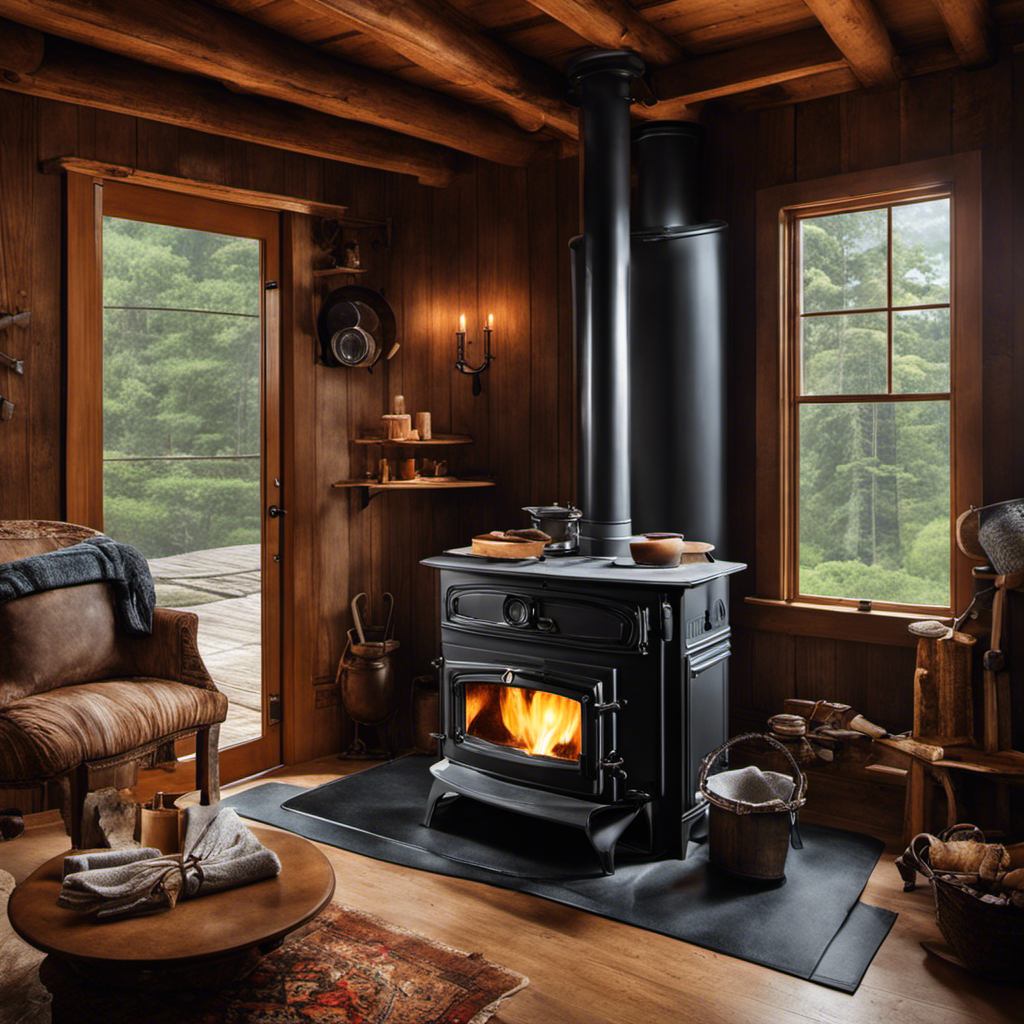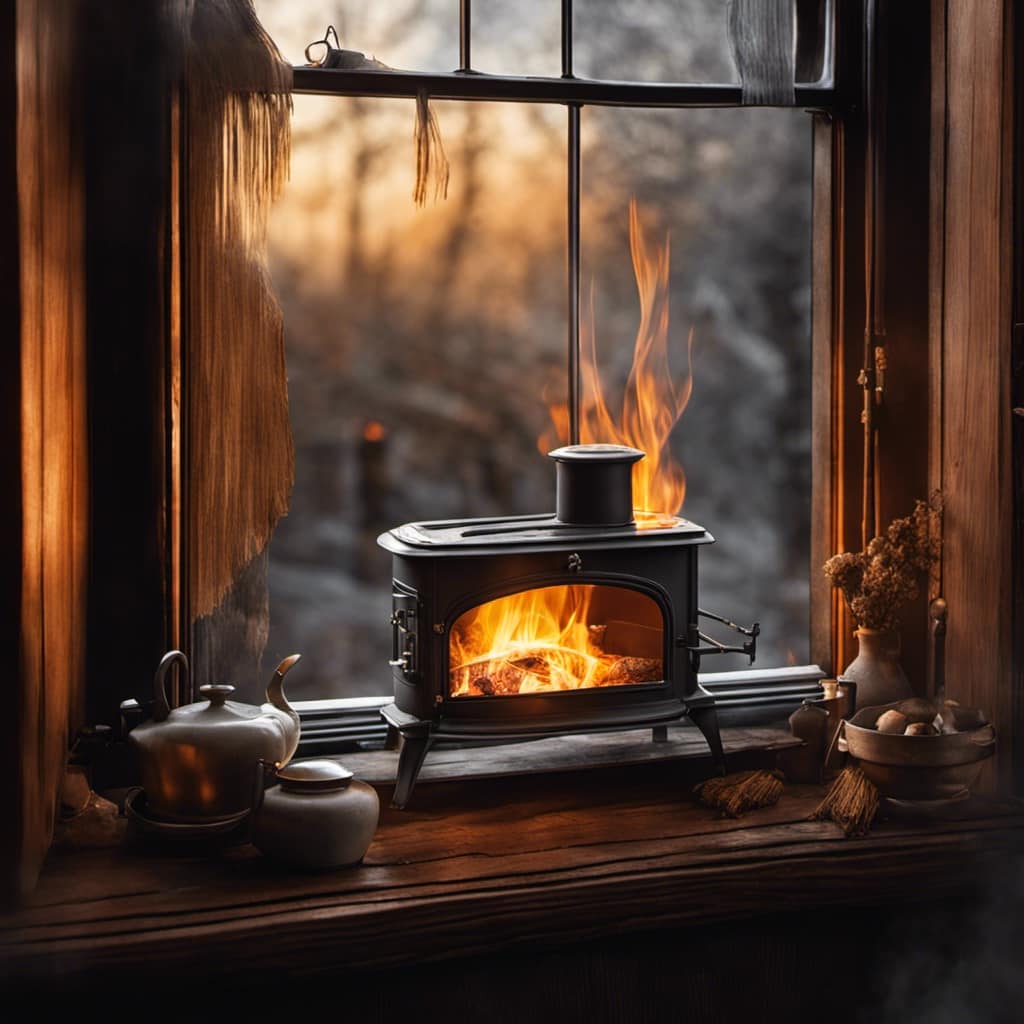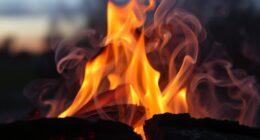As an enthusiast of wood stoves, I’m continually impressed by the substantial heat that these compact yet powerful devices are able to produce.
It’s amazing how something so compact can produce temperatures that rival larger heating options.
In this article, we’ll delve into the world of wood stove temperatures, exploring the factors that impact heat levels, comparing them to other heating options, and discussing safety considerations.
So, if you’re curious about just how hot a wood stove can get, keep reading for all the details.
Key Takeaways
- The temperature of a wood stove can be impacted by factors such as the type of wood, wood size, wood arrangement, air supply, and moisture content.
- Safety considerations for wood stove heat include proper installation and maintenance, maintaining a safe distance from flammable materials, using a heat shield and fireproof rug or floor protector, and having a fire extinguisher nearby.
- The maximum heat output of a wood stove depends on factors such as the type and quality of wood, wood storage and seasoning, stove design and combustion efficiency, heat regulation techniques, and insulation.
- Wood stove temperature can be controlled by adjusting air intake, using damper controls, managing stove draft, and opening or closing the damper to increase or decrease heat output. Safety precautions for overheating include monitoring for excessive smoke, checking for damaged or discolored stovepipes, feeling for excessive heat on the stove’s exterior, and recognizing signs of erratic stove behavior.
The Temperature Range of Wood Stoves
I can feel the intense heat radiating from a wood stove, as it can reach temperatures ranging from 400 to 900 degrees Fahrenheit. Several factors can affect the temperature of a wood stove.
The type and quality of the wood being burned play a crucial role. Hardwoods like oak and maple burn hotter and longer compared to softwoods like pine. The size and arrangement of the firewood also impact the temperature. Smaller pieces of wood ignite faster and burn hotter, while larger logs tend to burn slower and produce less heat. Another factor is the amount of air supply. Adequate airflow allows for more efficient combustion and higher temperatures.
Safety measures are essential when dealing with high heat from a wood stove. First and foremost, it’s crucial to have a properly installed and maintained stove. Regular cleaning and inspection ensure that the stove is functioning optimally and reduces the risk of fire hazards.
It’s important to keep a safe distance between the stove and any flammable materials. Installing a heat shield behind the stove can help protect the surrounding walls. Additionally, using a fireproof rug or floor protector can prevent accidental fires caused by embers or sparks. It’s also recommended to have a fire extinguisher nearby and to never leave a wood stove unattended.
Factors That Impact Wood Stove Heat Levels
One factor that affects the heat levels of a wood stove is the type of wood used as fuel. The quality of the wood can significantly impact the efficiency of the stove and how hot it can get. Here are some factors that can affect wood stove heat levels:
-
Moisture content: Wet or green wood contains a higher percentage of water, which requires more energy to burn off. This means that wet wood will produce less heat and may cause more smoke and creosote buildup in the stove.
-
Wood species: Different types of wood have different energy content and burn characteristics. Hardwoods like oak and maple have higher energy content and burn longer, producing more heat. Softwoods like pine burn faster and produce less heat.
-
Wood size: The size of the wood pieces used as fuel can impact heat levels. Smaller pieces burn faster and may produce more heat initially, but larger pieces can provide a longer, more sustained heat output.
-
Wood storage and seasoning: Properly storing and seasoning wood is crucial for optimal heat output. Wood should be stored in a dry, well-ventilated area and allowed to season for at least six months to reduce moisture content.
Understanding the Maximum Heat Output of Wood Stoves
Understanding the maximum heat output of wood stoves is crucial for ensuring efficient and safe operation. By knowing the factors that influence heat output, such as the type and quality of wood, the stove design, and the combustion efficiency, you can effectively control the temperature and heat output of your stove.
Additionally, taking necessary safety precautions to prevent overheating, such as using a thermometer, regularly cleaning the stove, and using proper ventilation, will help maintain a comfortable and safe environment.
Heat Output Factors
The heat output of a wood stove can depend on various factors. To ensure optimal heat regulation and efficiency, consider these important factors:
-
Heat Regulation Techniques: By using techniques such as adjusting the air intake and damper controls, you can control the rate at which the wood burns, thus affecting the heat output. This allows you to maintain a comfortable temperature in your space.
-
Impact of Insulation: Adequate insulation around your wood stove can help retain heat and prevent it from escaping. Properly insulated walls, floors, and ceilings will ensure that the heat generated by the stove is effectively distributed throughout the room, maximizing its warming potential.
-
Wood Quality and Moisture Content: Using dry, seasoned hardwood will result in a higher heat output compared to wet or unseasoned wood. Moisture content affects the combustion process and the amount of heat produced.
-
Stove Design and Size: The design and size of the wood stove can also impact its heat output. A larger stove with a well-designed combustion system will typically produce more heat, while a smaller stove may be more suitable for smaller spaces.
Controlling Stove Temperature
I can adjust the air intake and damper controls to regulate the temperature of my wood stove.
By controlling the stove draft, I can manage the amount of air that enters and exits the stove, thereby influencing the temperature.
The air intake control allows me to increase or decrease the amount of oxygen supplied to the fire, which directly affects its intensity and heat production.
By closing the damper, I can restrict the flow of exhaust gases, which slows down the combustion process and decreases the heat output.
On the other hand, by opening the damper, I can increase the airflow and promote a hotter fire.
Safety Precautions for Overheating
When my stove becomes too hot, I start to worry about potential safety hazards. Preventing overheating accidents is crucial to ensure the safety of your home and loved ones. Here are four signs of an overheating wood stove that you should never ignore:
-
Excessive smoke: If you notice an increase in smoke coming out of the stove, it could indicate that the stove is overheating.
-
Damaged or discolored stovepipes: Inspect the stovepipes regularly for any signs of damage or discoloration, as this could be a sign of excessive heat.
-
Hot exterior: If the exterior of your stove feels excessively hot to the touch, it may be overheating.
-
Erratic stove behavior: If your stove is behaving unpredictably, such as burning too quickly or struggling to maintain a consistent temperature, it may be a sign of overheating.
By being vigilant and recognizing these signs, you can take appropriate measures to prevent overheating accidents.
Transitioning into the next section, let’s now compare wood stove temperatures to other heating options.
Comparing Wood Stove Temperatures to Other Heating Options
When it comes to comparing wood stove temperatures to other heating options, it’s important to consider both efficiency and effectiveness.
While electric heaters may provide quick and convenient heat, they often struggle to match the warmth and coziness that a wood stove can offer.
Additionally, central heating systems may distribute heat more evenly throughout a home, but they can be costly to install and maintain.
Ultimately, the choice between these options will depend on individual preferences, budget, and the desired level of comfort.
Stove Vs. Electric Heater
In my experience, a wood stove tends to get hotter than an electric heater. Here are four reasons why this is the case:
-
Efficiency: Wood stoves are known for their high efficiency in converting fuel into heat. They’re designed to generate intense heat quickly, making them more effective at heating a space compared to electric heaters.
-
Energy consumption: Wood stoves use renewable resources like firewood, which can be more cost-effective and environmentally friendly compared to the electricity consumed by electric heaters.
-
Heat distribution: Wood stoves radiate heat in all directions, providing a cozy and warm atmosphere throughout the room. Electric heaters, on the other hand, tend to produce localized heat, making it less effective in heating larger areas.
-
Versatility: Wood stoves can also be used for cooking and water heating, making them a multi-purpose heating solution.
Considering these factors, it’s clear that a wood stove can provide superior heat output compared to an electric heater. However, when comparing it to central heating systems, there are other aspects to consider.
Stove Vs. Central Heating
When comparing a wood stove to central heating, there are several factors to consider, such as stove efficiency and energy consumption.
As someone who’s experience with both, I can confidently say that a wood stove offers certain advantages.
Stove efficiency refers to how effectively it converts fuel into heat. Wood stoves are known for their high efficiency, as they can reach temperatures of up to 1,000 degrees Fahrenheit, ensuring a consistent and warm heat output.
In terms of energy consumption, wood stoves are generally more efficient than central heating systems. They require less energy to operate and can provide heat even during power outages.
Additionally, using wood as a renewable fuel source can contribute to a more sustainable and eco-friendly heating solution.
Safety Considerations for High Heat Wood Stoves
I need to be cautious of the high heat generated by wood stoves for safety reasons. Wood stoves can reach extremely high temperatures, and it’s important to take necessary precautions to prevent accidents and ensure the safety of both people and property.
Here are four key points to consider when it comes to fire prevention and using heat resistant materials with wood stoves:
-
Fire Prevention: Wood stoves can pose a fire hazard if not properly maintained. Regularly clean the stove and chimney to remove creosote buildup, a highly flammable substance. Additionally, keep flammable materials such as curtains and furniture a safe distance away from the stove.
-
Heat Resistant Materials: When installing a wood stove, it’s crucial to use heat resistant materials such as fireproof bricks or tiles to protect the surrounding walls and floor. These materials can withstand the high temperatures generated by the stove and prevent the risk of fire.
-
Stovepipe Insulation: Insulating the stovepipe can help reduce heat transfer to the surrounding area. This can be achieved by using stovepipe insulation sleeves or wraps, which not only increase the stove’s efficiency but also minimize the risk of overheating nearby combustible materials.
-
Proper Ventilation: Adequate ventilation is essential to prevent the buildup of carbon monoxide, a colorless and odorless gas that can be emitted by wood stoves. Install carbon monoxide detectors in the vicinity of the stove, and ensure proper ventilation through a flue or chimney to expel any harmful gases.
Tips for Controlling and Adjusting Wood Stove Temperatures
Controlling and adjusting the temperature of my wood stove is crucial for maintaining a comfortable and safe environment in my home. Wood stoves provide a cozy and efficient way to heat our houses, but it’s important to know how to adjust the temperature to avoid overheating or underheating.
Here are some useful tips for adjusting wood stove temperatures and avoiding common mistakes.
Firstly, it’s important to start with a clean stove and use dry and seasoned firewood. Wet or green wood can create excess smoke and reduce the efficiency of your stove. To control the temperature, you can adjust the air vents. Opening the vents will increase the airflow, making the fire burn hotter, while closing them will decrease the airflow and reduce the temperature. It’s a good idea to start with the vents fully open until the fire is established, and then gradually adjust them to maintain the desired temperature.
Another tip is to use a stove thermometer to monitor the temperature inside your stove. This will help you avoid overheating, which can damage the stove and pose a safety risk. Additionally, using a stove fan can help distribute the heat more evenly throughout the room, preventing hot spots and cold spots.
Common mistakes in controlling wood stove temperatures include burning too much wood, which can cause the stove to overheat, and not using a damper or flue to control the airflow. It’s also important to avoid closing the air vents too soon, as this can lead to incomplete combustion and a smoky fire.
The Importance of Proper Maintenance for Wood Stove Efficiency
Proper maintenance is essential for maximizing the efficiency of your wood stove. As someone who’s owned and used a wood stove for years, I can attest to the importance of taking care of this valuable appliance.
Here are four reasons why proper maintenance is crucial for wood stove efficiency:
-
Safety: Regular maintenance helps identify potential issues such as cracks, leaks, or blockages that could compromise the safety of your stove. By addressing these problems promptly, you can ensure the safe operation of your wood stove.
-
Performance: A well-maintained wood stove functions at its optimal level, providing efficient heat output and even distribution throughout your home. With regular cleaning and inspection, you can enjoy a cozy and comfortable living space during the colder months.
-
Longevity: Just like any other appliance, a wood stove requires proper care to extend its lifespan. Regular maintenance, such as cleaning the flue, removing ash buildup, and inspecting the door gaskets, helps prevent premature wear and tear, ensuring your wood stove lasts for years to come.
-
Efficiency: A properly maintained wood stove burns fuel more efficiently, reducing energy waste and saving you money on heating costs. By cleaning the stovepipe, adjusting the damper, and ensuring proper airflow, you can maximize the heat output and minimize fuel consumption.
Frequently Asked Questions
What Are the Different Types of Wood Stoves Available in the Market?
When it comes to wood stoves, there are a few different types available in the market.
You’ve freestanding stoves, which are standalone units that can be placed anywhere in a room.
Then there are insert stoves, which are designed to be installed into an existing fireplace.
In addition, wood stoves can be either catalytic or non-catalytic.
Catalytic stoves use a catalyst to burn off smoke and reduce emissions, while non-catalytic stoves rely on secondary combustion to achieve the same result.
The efficiency and environmental impact of these different types vary, so it’s important to consider your needs and priorities when choosing a wood stove.
Are There Any Regulations or Guidelines for Wood Stove Installation and Usage?
Regulations and guidelines play a crucial role in wood stove installation and usage. They ensure safety and efficiency.
When it comes to wood stove installation, specific standards must be followed, including clearance requirements to combustible materials. Guidelines also cover proper chimney installation and maintenance to prevent the risk of fire.
Regular inspections are recommended to ensure compliance with regulations and to maintain safe operating temperatures. It’s essential to adhere to these guidelines for a worry-free wood stove experience.
Can Wood Stoves Overheat and Cause Damage to the Surrounding Area?
Wood stoves can indeed overheat and cause damage to the surrounding area if proper precautions aren’t taken. To prevent this, it’s important to follow fire safety guidelines for wood stove usage.
This includes maintaining a safe distance between the stove and any flammable materials, using a heat-resistant barrier, and regularly cleaning and inspecting the stove.
Additionally, using a thermometer to monitor the stove’s temperature and using proper ventilation can help prevent overheating and potential damage.
How Do I Know if My Wood Stove Is Reaching Its Maximum Heat Output?
Determining wood stove efficiency is crucial in maximizing heat output.
One way to know if your wood stove is reaching its maximum heat output is by monitoring the temperature. Use a stove thermometer to measure the temperature of the stove’s surface.
Keep in mind that different wood stoves have different maximum temperatures, so refer to the manufacturer’s guidelines.
Additionally, ensure proper ventilation and fuel management to optimize heat production.
Regular maintenance and cleaning also contribute to efficient heat output.
What Are the Potential Health Risks Associated With Using a Wood Stove?
Potential long-term effects of using a wood stove include respiratory problems. Wood stoves emit pollutants like fine particulate matter, carbon monoxide, and volatile organic compounds, which can be harmful when inhaled over time.
These pollutants can irritate the respiratory system, leading to symptoms like coughing, wheezing, and shortness of breath. Prolonged exposure may also increase the risk of developing chronic respiratory conditions such as asthma or chronic obstructive pulmonary disease (COPD).
It’s important to ensure proper ventilation and use dry, seasoned wood to minimize these health risks.
Conclusion
In conclusion, wood stoves can reach incredibly high temperatures, making them a powerful heating option. With proper maintenance and control, you can enjoy the cozy warmth they provide while ensuring safety.
So, if you’re looking for a heating solution that can turn your home into a toasty paradise, a wood stove is a scorching hot choice that will keep you toasty warm even in the coldest of winters!











